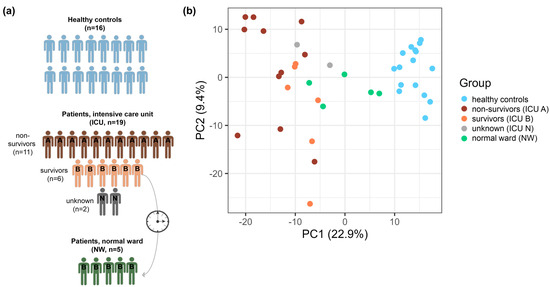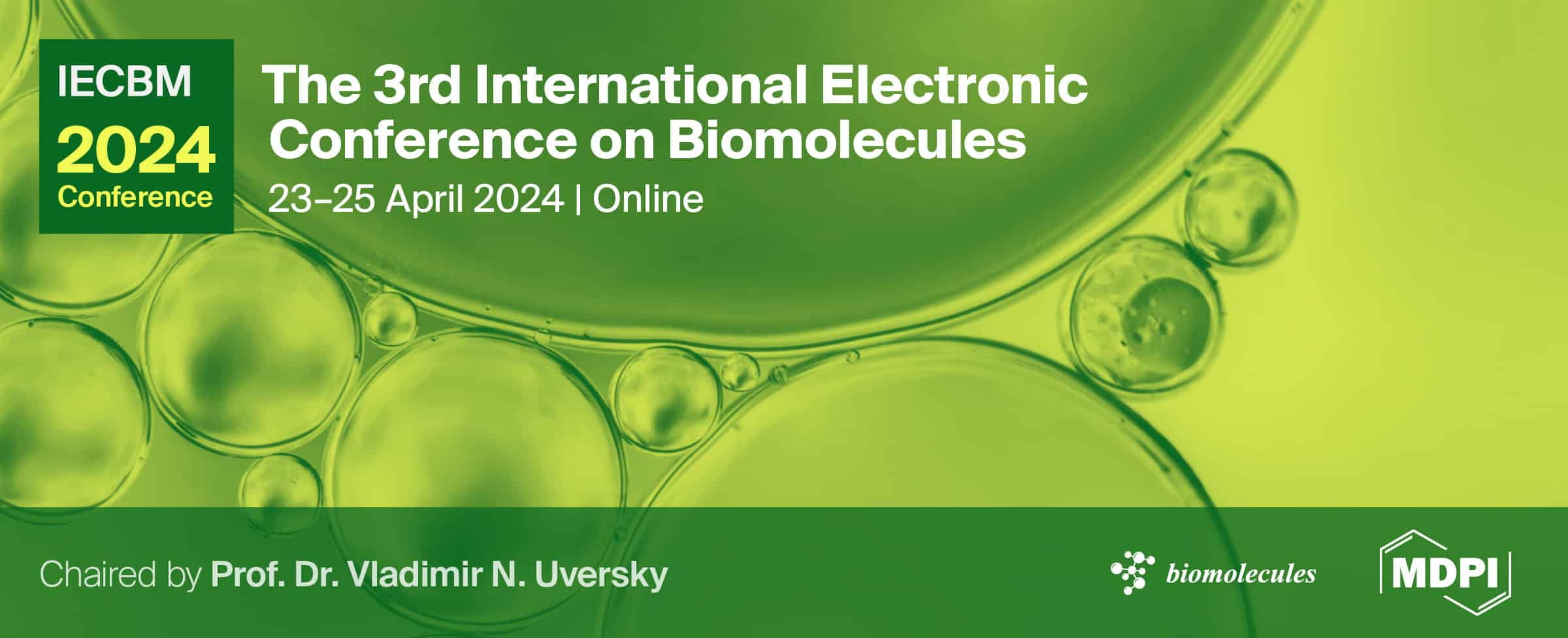Journal Description
Cells
Cells
is an international, peer-reviewed, open access journal of cell biology, molecular biology, and biophysics, published semimonthly online by MDPI. The Spanish Society for Biochemistry and Molecular Biology (SEBBM), Nordic Autophagy Society (NAS), Spanish Society of Hematology and Hemotherapy (SEHH) and Society for Regenerative Medicine (Russian Federation) (RPO) are affiliated with Cells and their members receive discounts on the article processing charges.
- Open Access— free for readers, with article processing charges (APC) paid by authors or their institutions.
- High Visibility: indexed within Scopus, SCIE (Web of Science), PubMed, MEDLINE, PMC, CAPlus / SciFinder, and other databases.
- Journal Rank: JCR - Q2 (Cell Biology) / CiteScore - Q1 (General Biochemistry, Genetics and Molecular Biology)
- Rapid Publication: manuscripts are peer-reviewed and a first decision is provided to authors approximately 18.8 days after submission; acceptance to publication is undertaken in 2.9 days (median values for papers published in this journal in the first half of 2023).
- Recognition of Reviewers: reviewers who provide timely, thorough peer-review reports receive vouchers entitling them to a discount on the APC of their next publication in any MDPI journal, in appreciation of the work done.
- Sections: published in 22 topical sections.
- Companion journal: Organoids.
Impact Factor:
6.0 (2022);
5-Year Impact Factor:
6.7 (2022)
Latest Articles
Changes in the Proteome of Platelets from Patients with Critical Progression of COVID-19
Cells 2023, 12(17), 2191; https://doi.org/10.3390/cells12172191 (registering DOI) - 01 Sep 2023
Abstract
Platelets, the smallest cells in human blood, known for their role in primary hemostasis, are also able to interact with pathogens and play a crucial role in the immune response. In severe coronavirus disease 2019 (COVID-19) cases, platelets become overactivated, resulting in the
[...] Read more.
Platelets, the smallest cells in human blood, known for their role in primary hemostasis, are also able to interact with pathogens and play a crucial role in the immune response. In severe coronavirus disease 2019 (COVID-19) cases, platelets become overactivated, resulting in the release of granules, exacerbating inflammation and contributing to the cytokine storm. This study aims to further elucidate the role of platelets in COVID-19 progression and to identify predictive biomarkers for disease outcomes. A comparative proteome analysis of highly purified platelets from critically diseased COVID-19 patients with different outcomes (survivors and non-survivors) and age- and sex-matched controls was performed. Platelets from critically diseased COVID-19 patients exhibited significant changes in the levels of proteins associated with protein folding. In addition, a number of proteins with isomerase activity were found to be more highly abundant in patient samples, apparently exerting an influence on platelet activity via the non-genomic properties of the glucocorticoid receptor (GR) and the nuclear factor κ-light-chain-enhancer of activated B cells (NFκB). Moreover, carbonic anhydrase 1 (CA-1) was found to be a candidate biomarker in platelets, showing a significant increase in COVID-19 patients.
Full article
(This article belongs to the Special Issue Platelet Biology and Functions)
►
Show Figures
Open AccessArticle
Attenuation of Oxidative Damage via Upregulating Nrf2/HO-1 Signaling Pathway by Protease SH21 with Exerting Anti-Inflammatory and Anticancer Properties In Vitro
Cells 2023, 12(17), 2190; https://doi.org/10.3390/cells12172190 (registering DOI) - 01 Sep 2023
Abstract
Oxidative damage and inflammation are among the very significant aspects interrelated with cancer and other degenerative diseases. In this study, we investigated the biological activities of a 25 kDa protease (SH21) that was purified from Bacillus siamensis. SH21 exhibited very powerful antioxidant
[...] Read more.
Oxidative damage and inflammation are among the very significant aspects interrelated with cancer and other degenerative diseases. In this study, we investigated the biological activities of a 25 kDa protease (SH21) that was purified from Bacillus siamensis. SH21 exhibited very powerful antioxidant and reactive oxygen species (ROS) generation inhibition activity in a dose-dependent approach. The mRNA and protein levels of antioxidant enzymes such as superoxide dismutase 1 (SOD1), catalase (CAT), and glutathione peroxidase 1 (GPx-1) were enhanced in the SH21-treated sample. SH21 also increased the transcriptional and translational activities of NF-E2-related factor 2 (Nrf2) with the subsequent development of detoxifying enzyme heme oxygenase-1 (HO-1). In addition, SH21 showed potential anti-inflammatory activity via inhibition of nitric oxide (NO) and proinflammatory cytokines, such as TNF-α, IL-6, and IL-1β, production in lipopolysaccharide (LPS)-stimulated RAW 264.7 cells. At concentrations of 60, 80, and 100 μg/mL, SH21 potentially suppressed nitric oxide synthase (iNOS) and cytokine gene expressions. Furthermore, SH21 significantly released lactate dehydrogenase (LDH) enzyme in cancer cell supernatant in a concentration-dependent manner and showed strong activity against three tested cancer cell lines, including HL-60, A549, and Hela. Our results suggest that SH21 has effective antioxidant, anti-inflammatory, and anticancer effects and could be an excellent therapeutic agent against inflammation-related diseases.
Full article
(This article belongs to the Special Issue Reactive Oxygen Species and Oxidative Stress in Cellular Homeostasis and Pathophysiology)
►▼
Show Figures
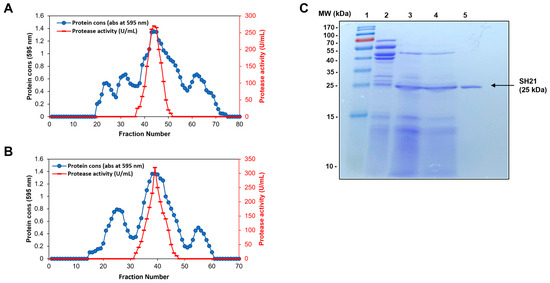
Figure 1
Open AccessReview
Current Advances in Cellular Approaches for Pathophysiology and Treatment of Polycystic Ovary Syndrome
Cells 2023, 12(17), 2189; https://doi.org/10.3390/cells12172189 - 31 Aug 2023
Abstract
Polycystic ovary syndrome (PCOS) is a prevalent gynecological and endocrine disorder that results in irregular menstruation, incomplete follicular development, disrupted ovulation, and reduced fertility rates among affected women of reproductive age. While these symptoms can be managed through appropriate medication and lifestyle interventions,
[...] Read more.
Polycystic ovary syndrome (PCOS) is a prevalent gynecological and endocrine disorder that results in irregular menstruation, incomplete follicular development, disrupted ovulation, and reduced fertility rates among affected women of reproductive age. While these symptoms can be managed through appropriate medication and lifestyle interventions, both etiology and treatment options remain limited. Here we provide a comprehensive overview of the latest advancements in cellular approaches utilized for investigating the pathophysiology of PCOS through in vitro cell models, to avoid the confounding systemic effects such as in vitro fertilization (IVF) therapy. The primary objective is to enhance the understanding of abnormalities in PCOS-associated folliculogenesis, particularly focusing on the aberrant roles of granulosa cells and other relevant cell types. Furthermore, this article encompasses analyses of the mechanisms and signaling pathways, microRNA expression and target genes altered in PCOS, and explores the pharmacological approaches considered as potential treatments. By summarizing the aforementioned key findings, this article not only allows us to appreciate the value of using in vitro cell models, but also provides guidance for selecting suitable research models to facilitate the identification of potential treatments and understand the pathophysiology of PCOS at the cellular level.
Full article
(This article belongs to the Special Issue Recent Advances in Mammalian Reproductive Biology—a Focus on Development of Gametes and Embryos)
►▼
Show Figures
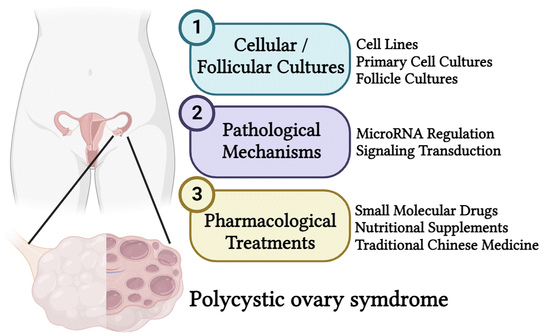
Graphical abstract
Open AccessArticle
A Protocol for Organoids from the Urine of Bladder Cancer Patients
by
, , , , , , , and
Cells 2023, 12(17), 2188; https://doi.org/10.3390/cells12172188 - 31 Aug 2023
Abstract
This study investigates the feasibility of establishing urine-derived tumor organoids from bladder cancer (BC) patients as an alternative to tissue-derived organoids. BC is one of the most common cancers worldwide and current diagnostic methods involve invasive procedures. Here, we investigated the potential of
[...] Read more.
This study investigates the feasibility of establishing urine-derived tumor organoids from bladder cancer (BC) patients as an alternative to tissue-derived organoids. BC is one of the most common cancers worldwide and current diagnostic methods involve invasive procedures. Here, we investigated the potential of using urine samples, which contain exfoliated tumor cells, to generate urine-derived BC organoids (uBCOs). Urine samples from 29 BC patients were collected and cells were isolated and cultured in a three-dimensional matrix. The establishment and primary expansion of uBCOs were successful in 83% of the specimens investigated. The culturing efficiency of uBCOs was comparable to cancer tissue-derived organoids. Immunohistochemistry and immunofluorescence to characterize the uBCOs exhibited similar expressions of BC markers compared to the parental tumor. These findings suggest that urine-derived BC organoids hold promise as a non-invasive tool for studying BC and evaluating therapeutic responses. This approach could potentially minimize the need for invasive procedures and provide a platform for personalized drug screening. Further research in this area may lead to improved diagnostic and treatment strategies for BC patients.
Full article
(This article belongs to the Collection Advances in 3D Cell Culture)
►▼
Show Figures
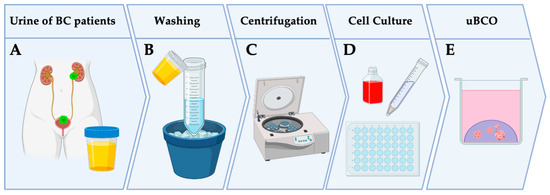
Figure 1
Open AccessReview
MT1-MMP as a Key Regulator of Metastasis
by
and
Cells 2023, 12(17), 2187; https://doi.org/10.3390/cells12172187 - 31 Aug 2023
Abstract
Membrane type1-matrix metalloproteinase (MT1-MMP) is a member of metalloproteinases that is tethered to the transmembrane. Its major function in cancer progression is to directly degrade the extracellular matrix components, which are mainly type I–III collagen or indirectly type IV collagen through the activation
[...] Read more.
Membrane type1-matrix metalloproteinase (MT1-MMP) is a member of metalloproteinases that is tethered to the transmembrane. Its major function in cancer progression is to directly degrade the extracellular matrix components, which are mainly type I–III collagen or indirectly type IV collagen through the activation of MMP-2 with a cooperative function of the tissue inhibitor of metalloproteinase-2 (TIMP-2). MT1-MMP is expressed as an inactive form (zymogen) within the endoplasmic reticulum (ER) and receives truncation processing via furin for its activation. Upon the appropriate trafficking of MT1-MMP from the ER, the Golgi apparatus to the cell surface membrane, MT1-MMP exhibits proteolytic activities to the surrounding molecules such as extracellular matrix components and cell surface molecules. MT1-MMP also retains a non-proteolytic ability to activate hypoxia-inducible factor 1 alpha (HIF-1A) via factors inhibiting the HIF-1 (FIH-1)-Mint3-HIF-1 axis, resulting in the upregulation of glucose metabolism and oxygen-independent ATP production. Through various functions of MT1-MMP, cancer cells gain motility on migration/invasion, thus causing metastasis. Despite the long-time efforts spent on the development of MT1-MMP interventions, none have been accomplished yet due to the side effects caused by off-target effects. Recently, MT1-MMP-specific small molecule inhibitors or an antibody have been reported and these inhibitors could potentially be novel agents for cancer treatment.
Full article
(This article belongs to the Special Issue Cellular and Molecular Mechanisms of Cancer Invasion and Metastasis)
►▼
Show Figures
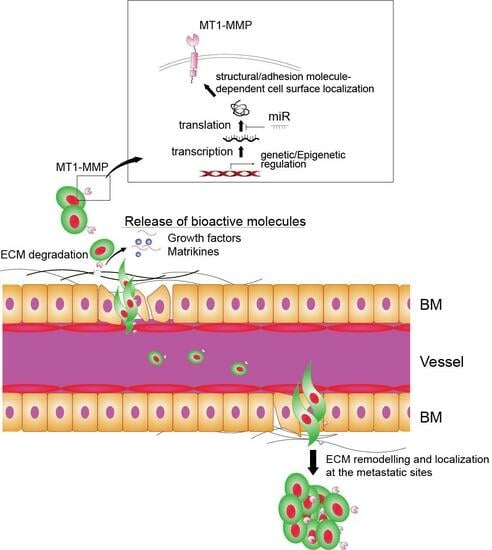
Graphical abstract
Open AccessComment
βIV-Spectrin in Cardiac Fibroblasts: Implications for Fibrosis and Therapeutic Targeting in Cardiac Diseases. Comment on Nassal et al. Spectrin-Based Regulation of Cardiac Fibroblast Cell-Cell Communication. Cells 2023, 12, 748
Cells 2023, 12(17), 2186; https://doi.org/10.3390/cells12172186 - 31 Aug 2023
Abstract
Fibroblasts in the heart, traditionally recognized as interstitial cells, have long been overlooked in the study of cardiac physiology and pathology [...]
Full article
(This article belongs to the Special Issue Research Advances Related to Cardiovascular System)
►▼
Show Figures
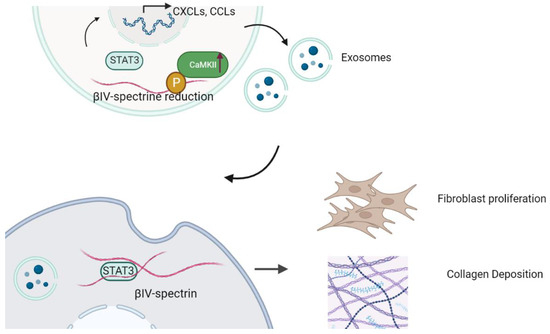
Figure 1
Open AccessArticle
Aquaglyceroporins in Human Breast Cancer
Cells 2023, 12(17), 2185; https://doi.org/10.3390/cells12172185 - 31 Aug 2023
Abstract
Aquaporins are water channels that facilitate passive water transport across cellular membranes following an osmotic gradient and are essential in the regulation of body water homeostasis. Several aquaporins are overexpressed in breast cancer, and AQP1, AQP3 and AQP5 have been linked to spread
[...] Read more.
Aquaporins are water channels that facilitate passive water transport across cellular membranes following an osmotic gradient and are essential in the regulation of body water homeostasis. Several aquaporins are overexpressed in breast cancer, and AQP1, AQP3 and AQP5 have been linked to spread to lymph nodes and poor prognosis. The subgroup aquaglyceroporins also facilitate the transport of glycerol and are thus involved in cellular metabolism. Transcriptomic analysis revealed that the three aquaglyceroporins, AQP3, AQP7 and AQP9, but not AQP10, are overexpressed in human breast cancer. It is, however, unknown if they are all expressed in the same cells or have a heterogeneous expression pattern. To investigate this, we employed immunohistochemical analysis of serial sections from human invasive ductal and lobular breast cancers. We found that AQP3, AQP7 and AQP9 are homogeneously expressed in almost all cells in both premalignant in situ lesions and invasive lesions. Thus, potential intervention strategies targeting cellular metabolism via the aquaglyceroporins should consider all three expressed aquaglyceroporins, namely AQP3, AQP7 and AQP9.
Full article
(This article belongs to the Special Issue Advances in Aquaporins II)
►▼
Show Figures
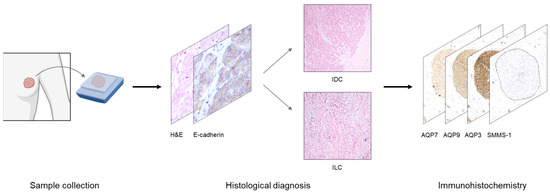
Figure 1
Open AccessArticle
miR-369-3p Modulates Intestinal Inflammatory Response via BRCC3/NLRP3 Inflammasome Axis
by
, , , , , and
Cells 2023, 12(17), 2184; https://doi.org/10.3390/cells12172184 - 31 Aug 2023
Abstract
Inflammasomes are multiprotein complexes expressed by immune cells in response to distinct stimuli that trigger inflammatory responses and the release of pro-inflammatory cytokines. Evidence suggests a different role of inflammasome NLRP3 in IBD. NLRP3 inflammasome activation can be controlled by post-translational modifications such
[...] Read more.
Inflammasomes are multiprotein complexes expressed by immune cells in response to distinct stimuli that trigger inflammatory responses and the release of pro-inflammatory cytokines. Evidence suggests a different role of inflammasome NLRP3 in IBD. NLRP3 inflammasome activation can be controlled by post-translational modifications such as ubiquitination through BRCC3. The aim of this study was to investigate the effect of miR-369-3p on the expression and activation of NLRP3 inflammasomes via BRCC3 regulation. After bioinformatics prediction of Brcc3 as a gene target of miR-369-3p, in vitro, we validated its modulation in bone marrow-derived macrophages (BMDM). The increase in miR-369-3p significantly reduced BRCC3 gene and protein expression. This modulation, in turn, reduced the expression of NLRP3 and blocked the recruitment of ASC adaptor protein by NLRP3. As a result, miR-369-3p reduced the activity of Caspase-1 by the inflammasome, decreasing the cleavage of pro-IL-1β and pro-IL-18. These results support a novel mechanism that seems to act on post-translational modification of NLRP3 inflammasome activation by BRCC3. This may be an interesting new target in the personalized treatment of inflammatory disorders, including IBD.
Full article
(This article belongs to the Special Issue Non-coding RNA Regulation of Stem Cell Regenerative Mechanisms: Advances, Challenges, and Perspectives)
►▼
Show Figures
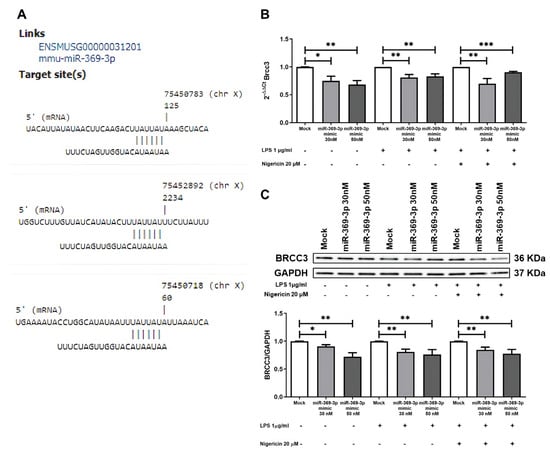
Figure 1
Open AccessReview
Mitochondrial Properties in Skeletal Muscle Fiber
by
and
Cells 2023, 12(17), 2183; https://doi.org/10.3390/cells12172183 - 30 Aug 2023
Abstract
Mitochondria are the primary source of energy production and are implicated in a wide range of biological processes in most eukaryotic cells. Skeletal muscle heavily relies on mitochondria for energy supplements. In addition to being a powerhouse, mitochondria evoke many functions in skeletal
[...] Read more.
Mitochondria are the primary source of energy production and are implicated in a wide range of biological processes in most eukaryotic cells. Skeletal muscle heavily relies on mitochondria for energy supplements. In addition to being a powerhouse, mitochondria evoke many functions in skeletal muscle, including regulating calcium and reactive oxygen species levels. A healthy mitochondria population is necessary for the preservation of skeletal muscle homeostasis, while mitochondria dysregulation is linked to numerous myopathies. In this review, we summarize the recent studies on mitochondria function and quality control in skeletal muscle, focusing mainly on in vivo studies of rodents and human subjects. With an emphasis on the interplay between mitochondrial functions concerning the muscle fiber type-specific phenotypes, we also discuss the effect of aging and exercise on the remodeling of skeletal muscle and mitochondria properties.
Full article
(This article belongs to the Special Issue Mitochondria: New Findings from Single Cells to Organs)
►▼
Show Figures

Figure 1
Open AccessPerspective
Metformin: A New Inhibitor of the Wnt Signaling Pathway in Cancer
by
, , , , , and
Cells 2023, 12(17), 2182; https://doi.org/10.3390/cells12172182 - 30 Aug 2023
Abstract
The biguanide drug metformin is widely used in type 2 diabetes mellitus therapy, due to its ability to decrease serum glucose levels, mainly by reducing hepatic gluconeogenesis and glycogenolysis. A considerable number of studies have shown that metformin, besides its antidiabetic action, can
[...] Read more.
The biguanide drug metformin is widely used in type 2 diabetes mellitus therapy, due to its ability to decrease serum glucose levels, mainly by reducing hepatic gluconeogenesis and glycogenolysis. A considerable number of studies have shown that metformin, besides its antidiabetic action, can improve other disease states, such as polycystic ovary disease, acute kidney injury, neurological disorders, cognitive impairment and renal damage. In addition, metformin is well known to suppress the growth and progression of different types of cancer cells both in vitro and in vivo. Accordingly, several epidemiological studies suggest that metformin is capable of lowering cancer risk and reducing the rate of cancer deaths among diabetic patients. The antitumoral effects of metformin have been proposed to be mainly mediated by the activation of the AMP-activated protein kinase (AMPK). However, a number of signaling pathways, both dependent and independent of AMPK activation, have been reported to be involved in metformin antitumoral action. Among these, the Wingless and Int signaling pathway have recently been included. Here, we will focus our attention on the main molecular mechanisms involved.
Full article
(This article belongs to the Special Issue From Mechanisms to Therapeutics: Wnt Signaling in Cancer)
►▼
Show Figures
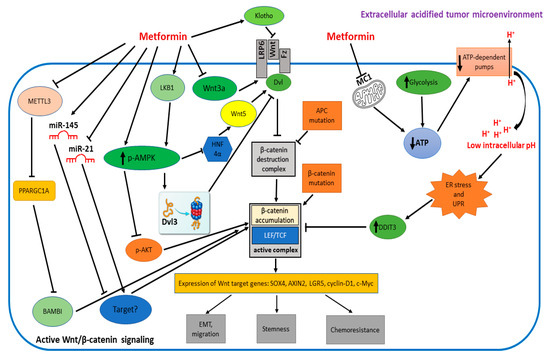
Figure 1
Open AccessReview
New Views of the DNA Repair Protein Ataxia–Telangiectasia Mutated in Central Neurons: Contribution in Synaptic Dysfunctions of Neurodevelopmental and Neurodegenerative Diseases
by
, , , , , and
Cells 2023, 12(17), 2181; https://doi.org/10.3390/cells12172181 - 30 Aug 2023
Abstract
Ataxia–Telangiectasia Mutated (ATM) is a serine/threonine protein kinase principally known to orchestrate DNA repair processes upon DNA double-strand breaks (DSBs). Mutations in the Atm gene lead to Ataxia–Telangiectasia (AT), a recessive disorder characterized by ataxic movements consequent to cerebellar atrophy or dysfunction, along
[...] Read more.
Ataxia–Telangiectasia Mutated (ATM) is a serine/threonine protein kinase principally known to orchestrate DNA repair processes upon DNA double-strand breaks (DSBs). Mutations in the Atm gene lead to Ataxia–Telangiectasia (AT), a recessive disorder characterized by ataxic movements consequent to cerebellar atrophy or dysfunction, along with immune alterations, genomic instability, and predisposition to cancer. AT patients show variable phenotypes ranging from neurologic abnormalities and cognitive impairments to more recently described neuropsychiatric features pointing to symptoms hardly ascribable to the canonical functions of ATM in DNA damage response (DDR). Indeed, evidence suggests that cognitive abilities rely on the proper functioning of DSB machinery and specific synaptic changes in central neurons of ATM-deficient mice unveiled unexpected roles of ATM at the synapse. Thus, in the present review, upon a brief recall of DNA damage responses, we focus our attention on the role of ATM in neuronal physiology and pathology and we discuss recent findings showing structural and functional changes in hippocampal and cortical synapses of AT mouse models. Collectively, a deeper knowledge of ATM-dependent mechanisms in neurons is necessary not only for a better comprehension of AT neurological phenotypes, but also for a higher understanding of the pathological mechanisms in neurodevelopmental and degenerative disorders involving ATM dysfunctions.
Full article
(This article belongs to the Topic Animal Models of Human Disease)
►▼
Show Figures
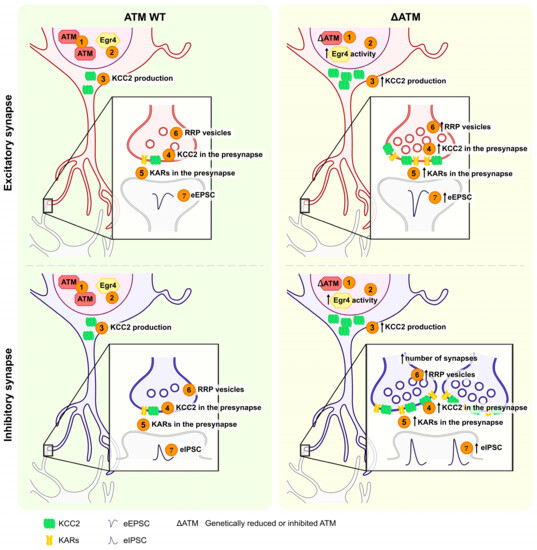
Figure 1
Open AccessSystematic Review
Arginine, Transsulfuration, and Folic Acid Pathway Metabolomics in Chronic Obstructive Pulmonary Disease: A Systematic Review and Meta-Analysis
by
and
Cells 2023, 12(17), 2180; https://doi.org/10.3390/cells12172180 - 30 Aug 2023
Abstract
There is an increasing interest in biomarkers of nitric oxide dysregulation and oxidative stress to guide management and identify new therapeutic targets in patients with chronic obstructive pulmonary disease (COPD). We conducted a systematic review and meta-analysis of the association between circulating metabolites
[...] Read more.
There is an increasing interest in biomarkers of nitric oxide dysregulation and oxidative stress to guide management and identify new therapeutic targets in patients with chronic obstructive pulmonary disease (COPD). We conducted a systematic review and meta-analysis of the association between circulating metabolites within the arginine (arginine, citrulline, ornithine, asymmetric, ADMA, and symmetric, SDMA dimethylarginine), transsulfuration (methionine, homocysteine, and cysteine) and folic acid (folic acid, vitamin B6, and vitamin B12) metabolic pathways and COPD. We searched electronic databases from inception to 30 June 2023 and assessed the risk of bias and the certainty of evidence. In 21 eligible studies, compared to healthy controls, patients with stable COPD had significantly lower methionine (standardized mean difference, SMD = −0.50, 95% CI −0.95 to −0.05, p = 0.029) and folic acid (SMD = −0.37, 95% CI −0.65 to −0.09, p = 0.009), and higher homocysteine (SMD = 0.78, 95% CI 0.48 to 1.07, p < 0.001) and cysteine concentrations (SMD = 0.34, 95% CI 0.02 to 0.66, p = 0.038). Additionally, COPD was associated with significantly higher ADMA (SMD = 1.27, 95% CI 0.08 to 2.46, p = 0.037), SDMA (SMD = 3.94, 95% CI 0.79 to 7.08, p = 0.014), and ornithine concentrations (SMD = 0.67, 95% CI 0.13 to 1.22, p = 0.015). In subgroup analysis, the SMD of homocysteine was significantly associated with the biological matrix assessed and the forced expiratory volume in the first second to forced vital capacity ratio, but not with age, study location, or analytical method used. Our study suggests that the presence of significant alterations in metabolites within the arginine, transsulfuration, and folic acid pathways can be useful for assessing nitric oxide dysregulation and oxidative stress and identifying novel treatment targets in COPD. (PROSPERO registration number: CRD42023448036.)
Full article
(This article belongs to the Special Issue Metabolomics Research in Chronic Obstructive Pulmonary Disease (COPD))
►▼
Show Figures
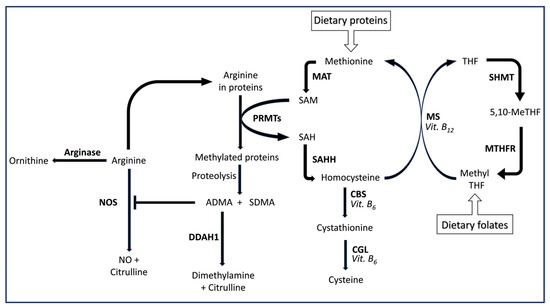
Figure 1
Open AccessArticle
Comparative Shotgun Proteomics Reveals the Characteristic Protein Signature of Osteosarcoma Subtypes
by
, , , , , , , , and
Cells 2023, 12(17), 2179; https://doi.org/10.3390/cells12172179 - 30 Aug 2023
Abstract
Osteosarcoma is a primary malignant bone tumor affecting adolescents and young adults. This study aimed to identify proteomic signatures that distinguish between different osteosarcoma subtypes, providing insights into their molecular heterogeneity and potential implications for personalized treatment approaches. Using advanced proteomic techniques, we
[...] Read more.
Osteosarcoma is a primary malignant bone tumor affecting adolescents and young adults. This study aimed to identify proteomic signatures that distinguish between different osteosarcoma subtypes, providing insights into their molecular heterogeneity and potential implications for personalized treatment approaches. Using advanced proteomic techniques, we analyzed FFPE tumor samples from a cohort of pediatric osteosarcoma patients representing four various subtypes. Differential expression analysis revealed a significant proteomic signature that discriminated between these subtypes, highlighting distinct molecular profiles associated with different tumor characteristics. In contrast, clinical determinants did not correlate with the proteome signature of pediatric osteosarcoma. The identified proteomics signature encompassed a diverse array of proteins involved in focal adhesion, ECM-receptor interaction, PI3K-Akt signaling pathways, and proteoglycans in cancer, among the top enriched pathways. These findings underscore the importance of considering the molecular heterogeneity of osteosarcoma during diagnosis or even when developing personalized treatment strategies. By identifying subtype-specific proteomics signatures, clinicians may be able to tailor therapy regimens to individual patients, optimizing treatment efficacy and minimizing adverse effects.
Full article
(This article belongs to the Topic Bone-Related Diseases: From Molecular Mechanisms to Therapy Development)
►▼
Show Figures
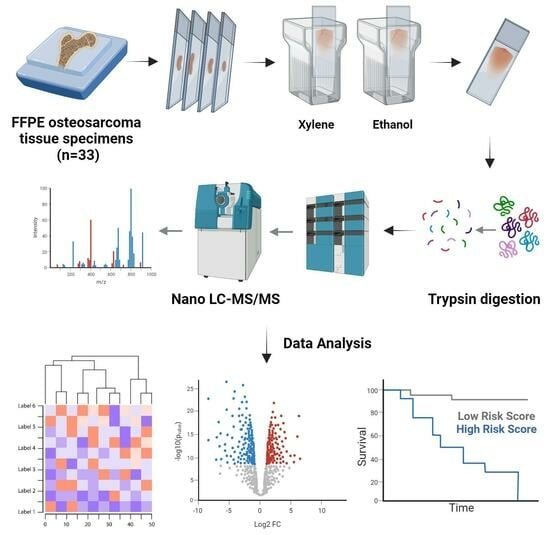
Graphical abstract
Open AccessArticle
The Preventive Effect of Melatonin on Radiation-Induced Oral Mucositis
by
, , , , , , , and
Cells 2023, 12(17), 2178; https://doi.org/10.3390/cells12172178 - 30 Aug 2023
Abstract
Melatonin exerts various physiological effects through melatonin receptors and their ability to scavenge free radicals. Radiotherapy is a common treatment for head and neck tumors, but stomatitis, a side effect affecting irradiated oral mucosa, can impact treatment outcomes. This study investigated the preventive
[...] Read more.
Melatonin exerts various physiological effects through melatonin receptors and their ability to scavenge free radicals. Radiotherapy is a common treatment for head and neck tumors, but stomatitis, a side effect affecting irradiated oral mucosa, can impact treatment outcomes. This study investigated the preventive effect of melatonin, a potent free radical scavenger, on radiation-induced oral mucositis. Mice were irradiated with 15 Gy of X-ray radiation to the head and neck, and the oral mucosa was histologically compared between a melatonin-administered group and a control group. The results showed that radiation-induced oral mucositis was suppressed in mice administered melatonin before and after irradiation. It was suggested that the mechanism involved the inhibition of apoptosis and the inhibition of DNA damage. From these findings, we confirmed that melatonin has a protective effect against radiation-induced oral mucositis.
Full article
(This article belongs to the Special Issue Cellular and Molecular Biology of Melatonin)
►▼
Show Figures
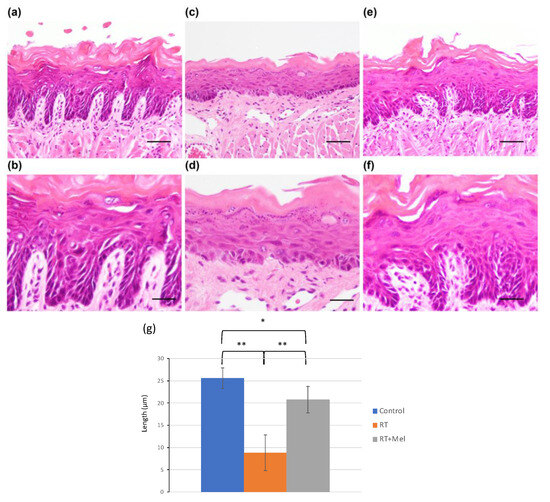
Figure 1
Open AccessArticle
Human Mast Cells Upregulate Cathepsin B, a Novel Marker of Itch in Psoriasis
by
, , , , , , , , and
Cells 2023, 12(17), 2177; https://doi.org/10.3390/cells12172177 - 30 Aug 2023
Abstract
Mast cells (MCs) contribute to skin inflammation. In psoriasis, the activation of cutaneous neuroimmune networks commonly leads to itch. To dissect the unique contribution of MCs to the cutaneous neuroinflammatory response in psoriasis, we examined their density, distribution, relation to nerve fibres and
[...] Read more.
Mast cells (MCs) contribute to skin inflammation. In psoriasis, the activation of cutaneous neuroimmune networks commonly leads to itch. To dissect the unique contribution of MCs to the cutaneous neuroinflammatory response in psoriasis, we examined their density, distribution, relation to nerve fibres and disease severity, and molecular signature by comparing RNA-seq analysis of MCs isolated from the skin of psoriasis patients and healthy volunteers. In involved psoriasis skin, MCs and Calcitonin Gene-Related Peptide (CGRP)-positive nerve fibres were spatially associated, and the increase of both MC and nerve fibre density correlated with disease severity. Gene set enrichment analysis of differentially expressed genes in involved psoriasis skin showed significant representation of neuron-related pathways (i.e., regulation of neuron projection along with dendrite and dendritic spine morphogenesis), indicating MC engagement in neuronal development and supporting the evidence of close MC–nerve fibre interaction. Furthermore, the analysis of 208 identified itch-associated genes revealed that CTSB, TLR4, and TACR1 were upregulated in MCs in involved skin. In both whole-skin published datasets and isolated MCs, CTSB was found to be a reliable indicator of the psoriasis condition. Furthermore, cathepsin B+ cells were increased in psoriasis skin and cathepsin B+ MC density correlated with disease severity. Therefore, our study provides evidence that cathepsin B could serve as a common indicator of the MC-dependent itch signature in psoriasis.
Full article
(This article belongs to the Special Issue Mast Cells in Immunity and Inflammation)
►▼
Show Figures
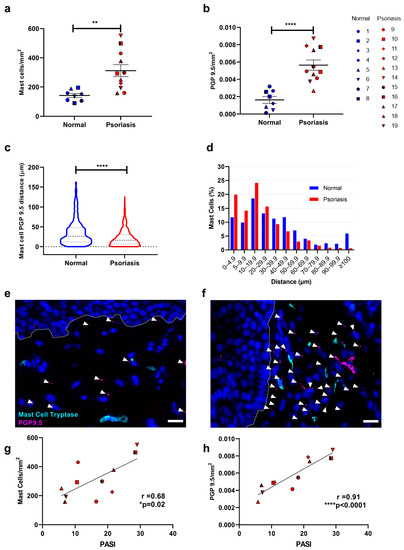
Figure 1
Open AccessArticle
Adverse Crosstalk between Extracellular Matrix Remodeling and Ferroptosis in Basal Breast Cancer
by
, , , , , and
Cells 2023, 12(17), 2176; https://doi.org/10.3390/cells12172176 - 30 Aug 2023
Abstract
(1) Background: Breast cancer is a frequent heterogeneous disorder diagnosed in women and causes a high number of mortality among this population due to rapid metastasis and disease recurrence. Ferroptosis can inhibit breast cancer cell growth, improve the sensitivity of chemotherapy and radiotherapy,
[...] Read more.
(1) Background: Breast cancer is a frequent heterogeneous disorder diagnosed in women and causes a high number of mortality among this population due to rapid metastasis and disease recurrence. Ferroptosis can inhibit breast cancer cell growth, improve the sensitivity of chemotherapy and radiotherapy, and inhibit distant metastases, potentially impacting the tumor microenvironment. (2) Methods: Through data mining, the ferroptosis/extracellular matrix remodeling literature text-mining results were integrated into the breast cancer transcriptome cohort, taking into account patients with distant relapse-free survival (DRFS) under adjuvant therapy (anthracyclin + taxanes) with validation in an independent METABRIC cohort, along with the MDA-MB-231 and HCC338 transcriptome functional experiments with ferroptosis activations (GSE173905). (3) Results: Ferroptosis/extracellular matrix remodeling text-mining identified 910 associated genes. Univariate Cox analyses focused on breast cancer (GSE25066) selected 252 individual significant genes, of which 170 were found to have an adverse expression. Functional enrichment of these 170 adverse genes predicted basal breast cancer signatures. Through text-mining, some ferroptosis-significant adverse-selected genes shared citations in the domain of ECM remodeling, such as TNF, IL6, SET, CDKN2A, EGFR, HMGB1, KRAS, MET, LCN2, HIF1A, and TLR4. A molecular score based on the expression of the eleven genes was found predictive of the worst prognosis breast cancer at the univariate level: basal subtype, short DRFS, high-grade values 3 and 4, and estrogen and progesterone receptor negative and nodal stages 2 and 3. This eleven-gene signature was validated as regulated by ferroptosis inductors (erastin and RSL3) in the triple-negative breast cancer cellular model MDA-MB-231. (4) Conclusions: The crosstalk between ECM remodeling-ferroptosis functionalities allowed for defining a molecular score, which has been characterized as an independent adverse parameter in the prognosis of breast cancer patients. The gene signature of this molecular score has been validated to be regulated by erastin/RSL3 ferroptosis activators. This molecular score could be promising to evaluate the ECM-related impact of ferroptosis target therapies in breast cancer.
Full article
(This article belongs to the Special Issue Novel Mechanisms and Therapeutic Opportunities of Ferroptosis)
►▼
Show Figures

Figure 1
Open AccessArticle
Recruitment of the Histone Variant MacroH2A1 to the Pericentric Region Occurs upon Chromatin Relaxation and Is Responsible for Major Satellite Transcriptional Regulation
by
, , , and
Cells 2023, 12(17), 2175; https://doi.org/10.3390/cells12172175 - 30 Aug 2023
Abstract
Heterochromatin formation plays a pivotal role in regulating chromatin organization and influences nuclear architecture and genome stability and expression. Amongst the locations where heterochromatin is found, the pericentric regions have the capability to attract the histone variant macroH2A1. However, the factors and mechanisms
[...] Read more.
Heterochromatin formation plays a pivotal role in regulating chromatin organization and influences nuclear architecture and genome stability and expression. Amongst the locations where heterochromatin is found, the pericentric regions have the capability to attract the histone variant macroH2A1. However, the factors and mechanisms behind macroH2A1 incorporation into these regions have not been explored. In this study, we probe different conditions that lead to the recruitment of macroH2A1 to pericentromeric regions and elucidate its underlying functions. Through experiments conducted on murine fibroblastic cells, we determine that partial chromatin relaxation resulting from DNA damage, senescence, or histone hyper-acetylation is necessary for the recruitment of macroH2A1 to pericentric regions. Furthermore, macroH2A1 is required for upregulation of noncoding pericentric RNA expression but not for pericentric chromatin organization. Our findings shed light on the functional rather than structural significance of macroH2A1 incorporation into pericentric chromatin.
Full article
(This article belongs to the Special Issue Epigenetics, Chromatin Structure and Transcription Regulation)
►▼
Show Figures
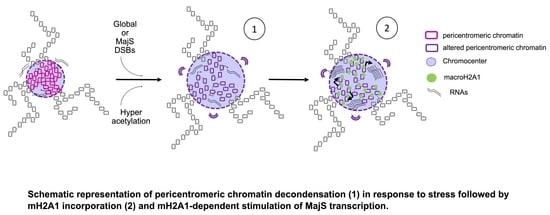
Graphical abstract
Open AccessArticle
Col1a2-Deleted Mice Have Defective Type I Collagen and Secondary Reactive Cardiac Fibrosis with Altered Hypertrophic Dynamics
by
, , , , , , , , , , , , and
Cells 2023, 12(17), 2174; https://doi.org/10.3390/cells12172174 - 30 Aug 2023
Abstract
Rationale: The adult cardiac extracellular matrix (ECM) is largely comprised of type I collagen. In addition to serving as the primary structural support component of the cardiac ECM, type I collagen also provides an organizational platform for other ECM proteins, matricellular proteins, and
[...] Read more.
Rationale: The adult cardiac extracellular matrix (ECM) is largely comprised of type I collagen. In addition to serving as the primary structural support component of the cardiac ECM, type I collagen also provides an organizational platform for other ECM proteins, matricellular proteins, and signaling components that impact cellular stress sensing in vivo. Objective: Here we investigated how the content and integrity of type I collagen affect cardiac structure function and response to injury. Methods and Results: We generated and characterized Col1a2−/− mice using standard gene targeting. Col1a2−/− mice were viable, although by young adulthood their hearts showed alterations in ECM mechanical properties, as well as an unanticipated activation of cardiac fibroblasts and induction of a progressive fibrotic response. This included augmented TGFβ activity, increases in fibroblast number, and progressive cardiac hypertrophy, with reduced functional performance by 9 months of age. Col1a2-loxP-targeted mice were also generated and crossed with the tamoxifen-inducible Postn-MerCreMer mice to delete the Col1a2 gene in myofibroblasts with pressure overload injury. Interestingly, while germline Col1a2−/− mice showed gradual pathologic hypertrophy and fibrosis with aging, the acute deletion of Col1a2 from activated adult myofibroblasts showed a loss of total collagen deposition with acute cardiac injury and an acute reduction in pressure overload-induce cardiac hypertrophy. However, this reduction in hypertrophy due to myofibroblast-specific Col1a2 deletion was lost after 2 and 6 weeks of pressure overload, as fibrotic deposition accumulated. Conclusions: Defective type I collagen in the heart alters the structural integrity of the ECM and leads to cardiomyopathy in adulthood, with fibroblast expansion, activation, and alternate fibrotic ECM deposition. However, acute inhibition of type I collagen production can have an anti-fibrotic and anti-hypertrophic effect.
Full article
(This article belongs to the Special Issue Cardiac Fibrosis: From Pathogenesis to Targeted Therapies)
►▼
Show Figures
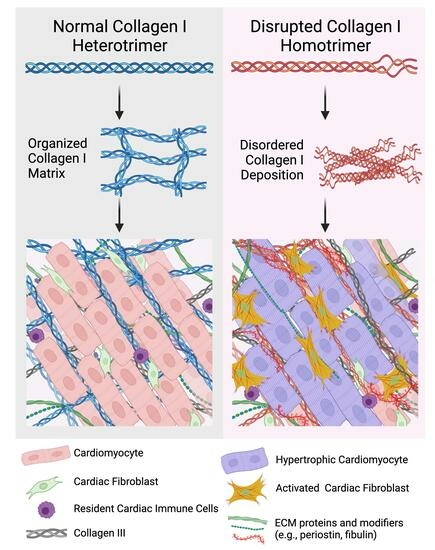
Graphical abstract
Open AccessArticle
Crosstalk between the Rod Outer Segments and Retinal Pigmented Epithelium in the Generation of Oxidative Stress in an In Vitro Model
Cells 2023, 12(17), 2173; https://doi.org/10.3390/cells12172173 - 30 Aug 2023
Abstract
Dysfunction of the retinal pigment epithelium (RPE) is associated with several diseases characterized by retinal degeneration, such as diabetic retinopathy (DR). However, it has recently been proposed that outer retinal neurons also participate in the damage triggering. Therefore, we have evaluated the possible
[...] Read more.
Dysfunction of the retinal pigment epithelium (RPE) is associated with several diseases characterized by retinal degeneration, such as diabetic retinopathy (DR). However, it has recently been proposed that outer retinal neurons also participate in the damage triggering. Therefore, we have evaluated the possible crosstalk between RPE and photoreceptors in priming and maintaining oxidative damage of the RPE. For this purpose, we used ARPE-19 cells as a model of human RPE, grown in normal (NG, 5.6 mM) or high glucose (HG, 25 mM) and unoxidized (UOx) or oxidized (Ox) mammalian retinal rod outer segments (OSs). ARPE-19 cells were efficient at phagocytizing rod OSs in both NG and HG settings. However, in HG, ARPE-19 cells treated with Ox-rod OSs accumulated MDA and lipofuscins and displayed altered LC3, GRP78, and caspase 8 expression compared to untreated and UOx-rod-OS-treated cells. Data suggest that early oxidative damage may originate from the photoreceptors and subsequently extend to the RPE, providing a new perspective to the idea that retinal degeneration depends solely on a redox alteration of the RPE.
Full article
(This article belongs to the Special Issue Recent Advances in Metabolism and Oxidative Stress in Human Diseases)
►▼
Show Figures
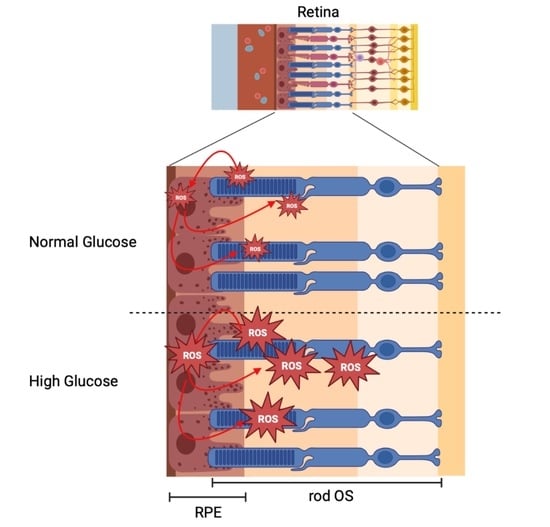
Graphical abstract
Open AccessArticle
Region-Specific Homeostatic Identity of Astrocytes Is Essential for Defining Their Response to Pathological Insults
by
, , , , , , , , and
Cells 2023, 12(17), 2172; https://doi.org/10.3390/cells12172172 - 30 Aug 2023
Abstract
The transformation of astrocytes into reactive states constitutes a biological response of the central nervous system under a variety of pathological insults. Astrocytes display diverse homeostatic identities that are developmentally predetermined and regionally specified. Upon transformation into reactive states associated with neurodegenerative diseases
[...] Read more.
The transformation of astrocytes into reactive states constitutes a biological response of the central nervous system under a variety of pathological insults. Astrocytes display diverse homeostatic identities that are developmentally predetermined and regionally specified. Upon transformation into reactive states associated with neurodegenerative diseases and other neurological disorders, astrocytes acquire diverse reactive phenotypes. However, it is not clear whether their reactive phenotypes are dictated by region-specific homeostatic identity or by the nature of an insult. To address this question, region-specific gene expression profiling was performed for four brain regions (cortex, hippocampus, thalamus, and hypothalamus) in mice using a custom NanoString panel consisting of selected sets of genes associated with astrocyte functions and their reactivity for five conditions: prion disease, traumatic brain injury, brain ischemia, 5XFAD Alzheimer’s disease model and normal aging. Upon transformation into reactive states, genes that are predominantly associated with astrocytes were found to respond to insults in a region-specific manner. Regardless of the nature of the insult or the insult-specificity of astrocyte response, strong correlations between undirected GSA (gene set analysis) scores reporting on astrocyte reactivity and on their homeostatic functions were observed within each individual brain region. The insult-specific gene expression signatures did not separate well from each other and instead partially overlapped, forming continuums. The current study demonstrates that region-specific homeostatic identities of astrocytes are important for defining their response to pathological insults. Within region-specific populations, reactive astrocytes show continuums of gene expression signatures, partially overlapping between individual insults.
Full article
(This article belongs to the Special Issue Pathogenesis of Prion Diseases)
►▼
Show Figures

Figure 1

Journal Menu
► ▼ Journal Menu-
- Cells Home
- Aims & Scope
- Editorial Board
- Reviewer Board
- Topical Advisory Panel
- Instructions for Authors
- Special Issues
- Topics
- Sections & Collections
- Article Processing Charge
- Indexing & Archiving
- Editor’s Choice Articles
- Most Cited & Viewed
- Journal Statistics
- Journal History
- Journal Awards
- Society Collaborations
- Conferences
- Editorial Office
Journal Browser
► ▼ Journal BrowserHighly Accessed Articles
Latest Books
E-Mail Alert
News
Topics
Topic in
Biomolecules, Cells, CIMB, IJMS, JMP, Molecules, Proteomes
Metalloproteins and Metalloenzymes
Topic Editors: Eugene A. Permyakov, Ludmilla Morozova-RocheDeadline: 30 September 2023
Topic in
Cells, Epigenomes, Genes, IJMS, IJTM
Stem Cell Differentiation and Applications
Topic Editors: Hiroyuki Hirai, Haiyun Pei, Atsushi AsakuraDeadline: 20 October 2023
Topic in
Cancers, Cells, Diagnostics, Future Pharmacology, Pharmaceutics
New Molecular Targets and Novel Strategies in Drug Development to Prevent Relapse in Acute Leukemia
Topic Editors: Oxana Dobrovinskaya, Ivan Delgado-EncisoDeadline: 31 October 2023
Topic in
Biomolecules, Cancers, Cells, JMP, Organoids, IJMS, Molecules
Molecular and Cellular Mechanisms of Cancers: Breast Cancer
Topic Editors: Yi Huang, Qun ZhouDeadline: 5 November 2023

Conferences
Special Issues
Special Issue in
Cells
Autophagy in Parkinson's Disease
Guest Editor: Cristine Alves Da CostaDeadline: 1 September 2023
Special Issue in
Cells
Intervertebral Disc Degeneration and Its Regeneration
Guest Editor: Hideki SudoDeadline: 10 September 2023
Special Issue in
Cells
Myasthenia Gravis and Innate Immunity—Dedicated to the Memory of Dr. Pia Bernasconi
Guest Editors: Paola Cavalcante, Renato MantegazzaDeadline: 30 September 2023
Special Issue in
Cells
Neurological Symptoms and COVID-19 Pandemic
Guest Editors: Nicola Montemurro, Luca Ricciardi, Alba ScerratiDeadline: 10 October 2023
Topical Collections
Topical Collection in
Cells
Hedgehog Signal Transduction in Physiology and Disease
Collection Editor: Natalia Riobo-Del Galdo
Topical Collection in
Cells
Cilia and Flagella: Structure, Function and Beyond
Collection Editors: William Tsang, Gang Dong







